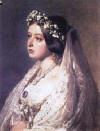 |
|
"It is in one's own power to be happy
and to be contented" |
| Queen Victoria was
born in 1819 as Alexandria Victoria. She took the
throne in 1837, she was just 18 years old. She
refused to have her overbearing mother tell her how to
run the throne. She took control of her own life
and her throne. She soon gained the love and
respect of her country. She was intelligent.
She was sincere and honest. She had a sense of
humor. She loved Pearls
and Cameos. She loved Flowers. She loved the
arts. She was considerate and tolerant of others -
she wanted to hear other people's opinions. She
loved animals. People loved her personality and
style. She spoke German, being from German
descent. When she learned to speak English, she
did so with no hint of a German accent. Queen
Victoria also learned to speak Italian because she loved
opera. |
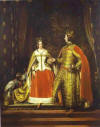

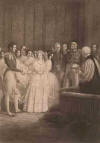
 |
| I must admit I am a
little of a romantic! I adore the love story
between Queen Victoria and Prince Albert. Yes,
they were cousins....but that happens in royalty.
They fell madly and deeply in love. They had a
mutual respect and admiration for each other. They
were completely devoted to each other. He was her
husband, her friend, her confidant and her top advisor.
They had 9 children together. |
| Albert died from
typhoid fever in 1861. Queen Victoria mourned for
the rest of her life - wearing black and secluding
herself in her castle. She said that she would
soon follow her beloved in death, but lived 40 years
more! She kept Albert's room in pristine condition
- it was maintained just as if her were still alive. |
| Queen Victoria
celebrated her 50 years as queen, her Golden Jubilee, in
1887. She once again embraced the public.
She toured England and visited other countries.
Her energy and optimism was once again embraced by
England. Her Diamond Jubilee was also a grand
celebration in 1897. She reigned for 64 years, the
longest reign in British history. She died in
1901at the age of 81. She was buried in a white
dress and her
wedding veil. |
|
The Victorian era is attributed to her personal tastes,
state of mind, ethics. She was more in touch with
the middle class that preceding monarchy. |
| Victorians were
sentimental people, loving
romance and symbolism.
During the Victorian era, virtue, modesty and
respectability were important attributes of one's
character. he Victorians were very concerned
with personal enhancement, this is evident in their
dress, jewelry, fabrics, home decor, gardening,
health/beauty secrets, handwriting, etc.
Victorians loved ornamentation - this is evident in
their cards, magazines and art. |
| The Victorian era was
one of optimism with exploration, medical
research/breakthroughs, invention, industrialization,
etc. People worked hard and strived for literacy
and higher education, thus the "middle class" was
formed. Family values, morals, faith, modesty,
proper decorum, etiquette and work ethic were important
to Victorians. |
| Railways allowed
Victorians to travel, thus increasing leisure time.
They could travel to sea-side resorts, races and
sporting events. Parlor games, puzzles, charades
and other forms of amusement were enjoyed by all.
Crafting, such as needlework, beads, cross stitch were
enjoyed by Victoria ladies. |
| Civic conscience,
social responsibility, gender and racial equality were
on the rise during the Victorian era. This was
true in the United States as well with the legal
abolishment of slavery. Also, humanitarian and
religious organizations (such as the Salvation Army)
reflected the Victorian concern for the poor and needy. |
|
More Resources About Queen Elizabeth: |
|
PBS "Queen
Victoria's Empire |
|
Kings and Queens of
The United Kingdom |
|
Women's History from About.Com |
|
Queen
Victoria: Grandmother of Europe |
|
Queen Victoria:
Images of Her World |
| |
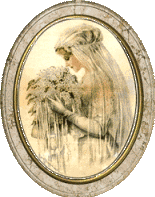 Victorian
Weddings... Victorian
Weddings... |
| The
white
wedding gown started during this period. It
became fashionable to copy Queen Victoria's wedding.
It was also a display of wealth to purchase a dress you
would only wear once. The Victorian bride also
favored a long
veil. Battenberg lace became very popular
during this time. Women's shoes were high button
or lace-ups. |
| Hats and gloves were
very important daily wear. Women wore dresses with
high colors, but party dresses actually showed cleavage. |
| Men wore stiff colors,
ascots, pocket watches, canes,
cuff links and top hats. Men's shoes had spats
(decorative shoe covering with buttons). |
| Some favorite wedding
favors during the Victorian era were: Jordan almonds and
chocolates shaped like cameos. |
| During the Victorian
era, Cake Pulls (also
known as Ribbon Pulls or a Charm Cake) were very
popular (cake charms
are still very popular today!) |
| Victorians loved
ornamentation, so invitations and cards were beautiful
and formal. Invitations were usually engraved and
cards were coved with decorations. |
| The Victorian era was
the peek of the English tea fetish. Finger food
receptions became popular. Garden tea parties were
fashionable.
Wedding
cakes were sometimes fruit cakes with rolled fondant
icing. |
| Victorian weddings
were full of flowers
that had special meanings to the bride.
Bridesmaids would carry their flowers in silver tussy
mussys. When a lady received flowers from a
gentleman, there was a message he was conveying. |
| For more information
about the Victorian era: |
|
Victoriana |
|
The Victorian
Wedding |
|
Victorian Websites |
|
Victorian Station |
| |
|
Contact Us |
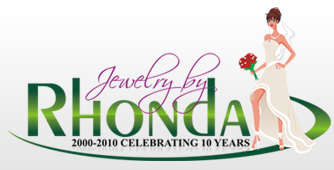





 Victorian
Weddings...
Victorian
Weddings...